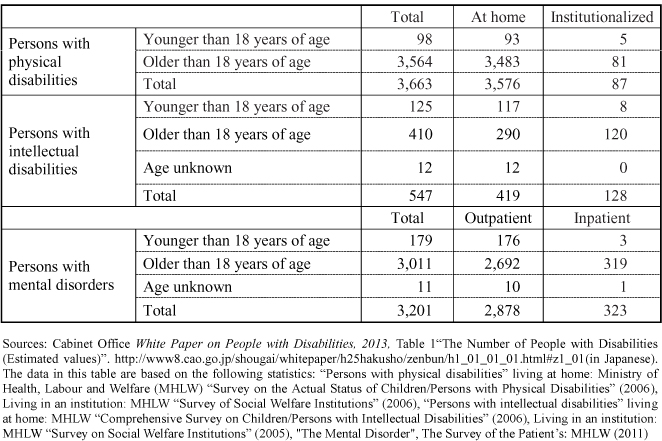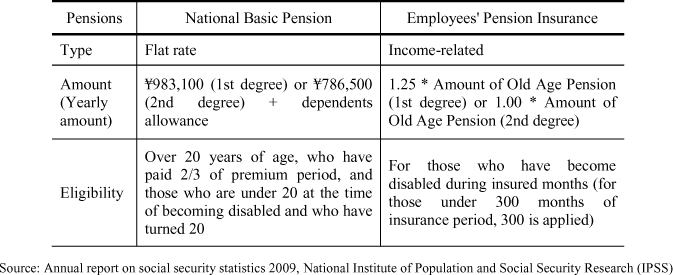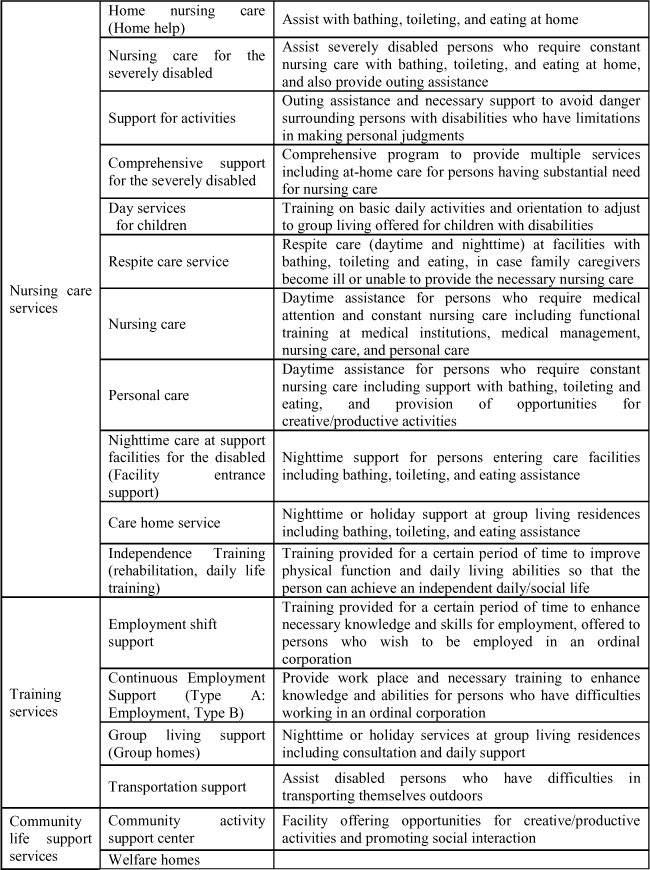8.1 Policy for people with disabilities in Japan
Internationally, the government of Japan signed the Convention of Rights of People with Disabilities in 2007, but it has not been ratified yet. Since the number of countries who have ratified this convention is as many as 138 (as of October 2013), the Japanese government improves various social measures for people with disabilities, and is preparing conditions so that ratification of the convention may be made.
Under six welfare acts, including the Public Assistant Act, Child Welfare Act, Act on Welfare of Physically Disabled Persons, Act on Welfare of Mentally Retarded Persons, Act on Social Welfare Service for Elderly, Act on Welfare of Mothers with Dependents and Widows, services are provided to people with needs of such services. The welfare system according to the type of disability (physical disability, mental retardation, mental diseases) caused the difference that the level of the facilities accommodation and the user-charge of the medical expense are different in each type of disability. Since the number of people with physical disabilities, people with mental retardation, and people with mental diseases amounts to 3,663,000, 547,000, and 3,233,000 respectively in the middle of the 2000s (Table 8.1), it is necessary to unify systems and to reduce differences between the systems by the kind of disability.
Table 8.1 The number of people with disabilities in 1,000 (2013)
In order to establish the coordination between such systems classified by the type of disability, the Services and Supports for Persons with Disabilities Act (SSPDA) was enacted in 2005. Based on this act, a new scheme of service for three types of disabilities, including physical disabilities, mental retardation, and mental diseases, was introduced in 2006. However, there was a strong resistance to introduce cost sharing among people with disabilities. Under the Democratic Party, the discussion of reforming SSPDA was started and the amendment bill including the reexamination of cost sharing (i.e., mitigation of user charge according to income) was approved in the Parliament in December 2010. Finally the effort of such law revision bore fruit, and a new law (the Act for Comprehensive Welfare for Persons with Disabilities) that corrected various incompleteness of SSPDA was enacted in June 2012.
8.2 Various forms of support
8.2.1 Income support
The National Pension includes a scheme for adults with disabilities. It is called the Disability Basic Pension. The pensioners include the persons who obtained disabilities in his/her childhood and those who were born with disabilities. The Employee Pension includes a scheme for former employees who became disabled while they were employed. Under the mutual aid associations, there are similar schemes for former employees with disabilities including civil servants both of central/local governments and teachers/employees of private schools. Also, under the Workers’ Accident Compensation Insurance, employees can receive pension for the loss of ability due to injury and sickness at work. There are also similar workers’ accident compensation schemes for civil servants.
Table 8.2 Income support for the People with Disabilities, 2012
Other than public pension benefits, there are allowances paid under certain conditions of disability by local authorities. However, the allowance is not a universal scheme, but an individual local authority provides it out of its own budget.
8.2.2 Service to support people with disabilities
The Act for Comprehensive Welfare for Persons with Disabilities was promulgated in June 2012, and reorganized the scheme of service for people including children under 18 years old with disabilities. The Act aims at three goals. The first is an inclusive policy of three types of disabilities, i.e. physical, intellectual, and mental disabilities. The second is a reorganization of services providing schemes in order to position the people with disabilities in the center. The third is enforcement of active labor participation of people with disabilities.
Table 8.3 Scheme of service under the Services and Supports
for Persons with Disabilities Act (SSPDA)
Source: Web-site of Ministry of Health, Welfare and Labour
(
http://www.mhlw.go.jp/bunya/shougaihoken/service/taikei.html).
The residential service regrouped with two types, which is day activities and residential support. Within the day activities, there are the care benefit, the training benefit, and the community based support programs. (See the Table 8.3)
8.2.3 Promotion of vocational rehabilitation services and employment of people with disabilities
As there are lots of challenges for people with disabilities to be employed, vocational rehabilitation services that include vocational evaluation and guidance, work preparation support, assessment of persons with intellectual disabilities, and comprehensive employment support for persons with mental disabilities are very important. These services are provided by Local Vocational Centers and Large Region Vocational Centers for People with Disabilities under the Law for Employment Promotion of Persons with Disabilities.
The employment of people with disabilities in many cases requires employers to pay extra costs for preparing special accommodation in the workplace facility, equipment, and environment modifications, and adoption of special personnel management programs. In order to promote and secure employment of people with disabilities, the government provides the subsidy that fills up these costs of the company employing the people with disabilities. On the other hand, the government imposes a surcharge if a company does not attain the employment rate for the people with disabilities. This system (The levy and grant system for employing people with disabilities) is enforced under the “Law for Employment Promotion of Persons with Disabilities.”
8.3 Current Issues
There are similarities between welfare services for people with disabilities and long-term care for the elderly in terms of offering care to the person who has needs. The recent reform of the long-term care insurance for the elderly greatly promoted replacing the facility centered services with the integrated community care support coupled with home care services. A similar trend is now starting for the environment surrounding persons with disabilities, so that they can continue to live in the community which they got used to. According to the flow of such reforms, the Law for Promotion of Dissolution of the Discrimination for People with Disabilities was enacted at last in 2013. By this law, one of the conditions of ratifying the Convention of Rights of People with Disabilities is filled, and the day of ratification is approaching even in Japan. The welfare policy for people with disabilities in Japan is continuing to develop along with the current improvement of global welfare, though there are remaining various tasks.



